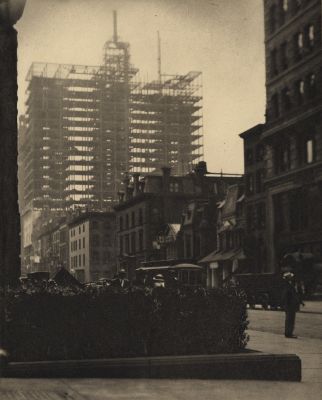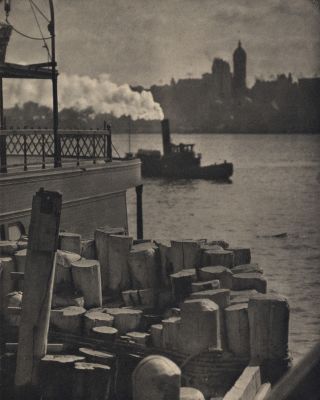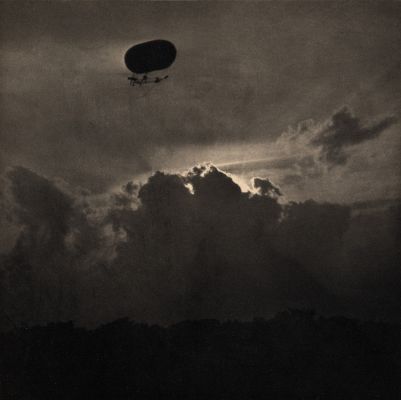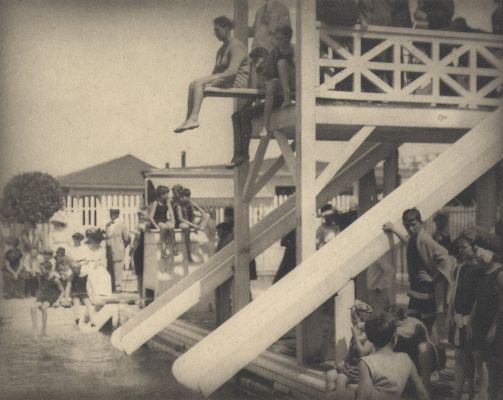
Title
The SteerageArtist
Stieglitz, Alfred (American, 1864-1946)Key FigurePublication
Camera Work XXXVIDate
1907Process
PhotogravureAtelier
Manhattan Photogravure Company, NYImage Size
19.7 x 15.8 cm
As Stieglitz told the story, in 1907 he, his wife and daughter embarked on a sea cruise to Europe on the ocean liner, the SS Kaiser Wilhelm II to visit relatives and friends. The Wilhelm was one of the largest and fastest ships in the world at that time. It was divided into three levels or decks, reflecting the classes, first, second and third, or steerage. It was the steerage passengers who provided the profit margins for the companies when they were ferried to New York. There they passed into the New World, through Ellis Island–or not. The people photographed by Stieglitz were the poor people – peasants and proletariat – being returned to their nation of origin, not accepted into in the United States.
According to Stieglitz, sometime after their third day of travel, restless and tired of the sterility of first-class travel, he went for a walk around the ship and came upon a viewpoint that looked down toward the Steerage passenger area. He remarked: "The scene fascinated me: A round straw hat; the funnel leaning left, the stairway leaning right; the white drawbridge, its railings made of chain; white suspenders crossed on the back of a man below; circular iron machinery; a mast that cut into the sky, completing a triangle…. simple people; the feeling of ship, ocean, sky; a sense of release that I was away from the mob called ‘rich.’ Rembrandt came into my mind, and I wondered would he have felt as I did. I raced… to my cabin, picked up my Graflex, raced back again, worrying whether or not the man with the straw hat had shifted his position. If he had, the picture I saw would no longer exist…No one had moved…. I released the shutter, my heart thumping. If I had captured what I wanted, the photograph would go far beyond any of my previous prints. It would be a picture based on related shapes and deepest human feeling – a step in my own evolution, a spontaneous discovery" [1].
The Steerage began its life as a masterpiece four years later, with Stieglitz’s publication of it in the 1911 issue of Camera Work XXXVI. The issue was devoted exclusively to his photographs in the "new" style, together with a Cubist drawing by Picasso. Stieglitz loved to recount how the great painter had praised the collage-like dispersal of forms and shifting depths of The Steerage. Canonized retroactively, the photograph allowed Stieglitz to put his chosen medium on par with the experimental European painting and sculpture he imported and exhibited at his gallery.
With the publication of The Steerage as a photogravure, Stieglitz made a visual argument for straight photography and its association to a personal symbolism as the dominant paradigm of modernism, recognizable by several aesthetic tenets including sharp overall focus, dramatic black and white contrasts within a full range of tone, and subjects of modern life that lend themselves to being perceived in terms of abstract formal arrangements that speak to the photographer’s interior state. Of The Steerage, Stieglitz later said, in a bid to reframe photography in terms of formalism, “I saw a picture of shapes and underlying that the feeling I had about life.”
There are those who wish to replace the image within the social and political currents of the time, but Stieglitz did not see the human tragedy before his eyes. Perhaps because of the coincidence of The Steerage and Les Demoiselles d’Avignon being executed in the same year, 1907, and because Pablo Picasso admired the photograph, there are those who wish to place the composition within the confines of Cubism, but Cubism and its new visual vocabulary had not yet been invented. That said, like Picasso, Stieglitz was transitioning away from painterly prints of Symbolist subjects to a more straightforward depiction of daily life opening passageway into a new future for photography. [2]
Reproduced / Exhibited
America & Alfred Stieglitz: A Collective Portrait. Garden City, N.Y: Literary Guild, 1934. (cover)
Benson, Richard, and Gary L. Haller. The Physical Print: A Brief Survey of the Photographic Process. New Haven: Jonathan Edwards College, 2005.no. 28
Frank, Waldo D. America and Alfred Stieglitz: A Collective Portrait. New York: Aperture, 1979. pl. 9
Frizot, Michael. New History of Photography. Place of publication not identified: Pajerski, 1999. Print p. 393
Gernsheim, Helmut. Creative Photography. Aesthetic Trends 1839-1960. [with Illustrations.]. London: Faber & Faber, 1962. p. 150
Greenough, Sarah, and Alfred Stieglitz. Alfred Stieglitz: The Key Set : the Alfred Stieglitz Collection of Photographs. Washington, D.C: National Gallery of Art, 2002. Pl 310
Homer, William I. Alfred Stieglitz and the Photo-Secession. Boston: Little, Brown and Company, 1983. no. 99
Jussim, Estelle. Slave to Beauty: The Eccentric Life and Controversial Career of F. Holland Day, Photographer, Publisher, Aesthete. Boston: Godine, 1981. p. 188
Kicken, Annette, Georg Kargl, and Rudolf Kicken. Pictorialism: Hidden Modernism. Berlin: Kicken, 2008. back cover.
Marien, Mary W. Photography: A Cultural History. Englewood Cliffs, NJ: SunSoft Press, 2002. fig. 4.21.
Newhall, Nancy L, and Beaumont Newhall. Masters of Photography. New York: A. W. Visual Library, 1985. p. 61
Peterson, Christian A. Camera Work: Process & Image : [exhibition, Minneapolis, Minneapolis Institute of Arts, August 31-November 3, 1985, Seattle, Seattle Art Museum, November 22, 1985-February 2, 1986]. Minneapolis: Minneapolis Institute of arts, 1985. Frntis.
Pollack, P. The Picture History of Photography: From the Earliest Beginnings to the Present Day. New York: Harry N. Abrams, Inc, 1998. p. 266
Smith, Joel, and Edward Steichen. Edward Steichen: The Early Years. Princeton, NJ. [etc.: Princeton University Press, 1999.p. 33
Stieglitz, Alfred, Richard Whelan, and Sarah Greenough. Stieglitz on Photography: His Selected Essays and Notes. New York, NY: Aperture Foundation, 2000. p. xxiv
Stevenson, Sara, and Duncan Forbes. A Companion Guide to Photography in the National Galleries of Scotland. Edinburgh: National Galleries of Scotland, 2009. p. 126
Doty, Robert M. Photo-secession: Photography As a Fine Art. N.Y: Eastman, 1960. plate 1.
Rocha, Regina M, Paul Strand, and Helouise Costa. A Poética Fotográfica De Paul Strand. São Paulo, Brazil: Editora da Universidade de São Paulo, 2012. Fig. 15
Rosenblum, Naomi. A World History of Photography. New York: Abbeville Press, 2008. no. 402.
Stieglitz, Alfred, and Dorothy Norman. Alfred Stieglitz. New York: Aperture, 1976. p. 47.
Witkin, , London, and Shestack. The Photograph Collector’s Guide. London: Secker & Warburg, 1979. p. 20
References
[1] Norman Dorothy. Alfred Stieglitz : An American Seer. Aperture 1990.
[2] Frizot, Michel. A New History of Photography. 1999. p. 393
National Gallery of Art, Washington (ed.), Alfred Stieglitz. The key set. The Alfred Stieglitz collection of photographs, Bd. 1. 1886 – 1922, New York 2002, S. 190-194
Katherine Hoffman, Stieglitz. A beginning light, New Haven et al. 2004, p. 234 with ill.











